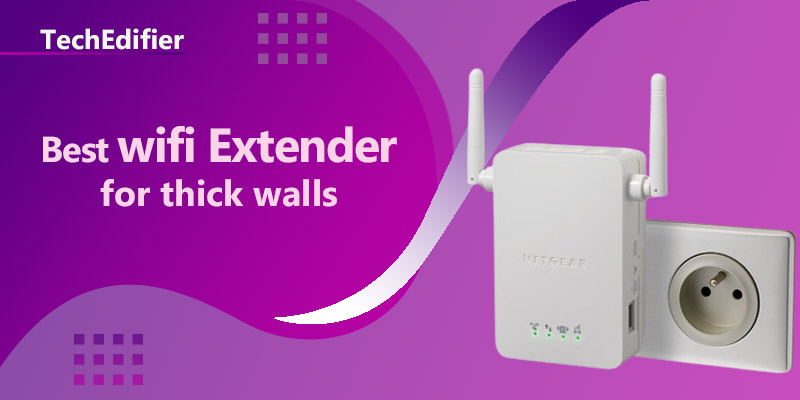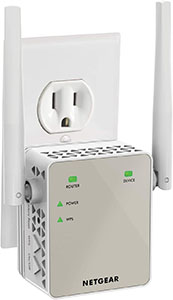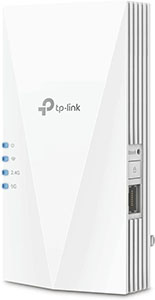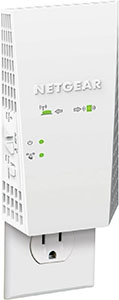When choosing a wifi extender for thick walls, it’s important to consider the following features:
- High power: Look for a wifi extender with a high-powered amplifier that can boost the signal strength and penetrate thick walls.
- Dual-band: A dual-band wifi extender that supports both 2.4GHz and 5GHz frequencies can provide better penetration and stability through thick walls.
- Antennas: Look for a wifi extender with multiple high-gain antennas, as they can help to expand the coverage and improve the signal strength.
- Range: Choose a wifi extender with a large coverage range, as it will be able to extend the wifi signal to the areas in your home that are furthest away from your router.
- Quality of Service(QoS) : Good Quality of Service options can help to prioritize important traffic such as video streaming or gaming, ensuring a stable and fast connection.
- Compatibility: Make sure the wifi extender is compatible with your router and any other devices you want to connect to it.
- Brand reputation: Choose a wifi extender from a reputable brand, as they tend to have better performance and support.
Some examples of wifi extenders that may be suitable for thick walls include the TP-Link AC1900, the NETGEAR Nighthawk X6S, and the D-Link DAP-1650.
It’s important to note that even with the most powerful wifi extender, it can be difficult to get a strong signal through thick walls and other obstacles. In this case, you might consider other options such as Powerline adapters, or consider moving the router to a central location, to get better coverage.
You can also read more about the best wifi extender for blink cameras.
Top Rated 7 best wifi extender for thick walls
1: NETGEAR Wi-Fi Range Extender EX6120 – Coverage Up to 1500 Sq Ft and 25 Devices
The NETGEAR Wi-Fi Range Extender EX6120 is a high-performance wifi extender that can provide coverage for up to 1500 sq ft and support for up to 25 devices. Here are some of its top features:
- Dual-Band: It supports both 2.4GHz and 5GHz frequencies, which can provide better penetration and stability through thick walls.
- High-powered amplifiers: It has high-powered amplifiers that can boost the signal strength and penetrate thick walls.
- Easy setup: The EX6120 is easy to set up with the NETGEAR Nighthawk App, which guides you through the process step-by-step.
- Gigabit Ethernet: It has a Gigabit Ethernet port, which allows you to connect a wired device such as a gaming console or smart TV to the extender.
- Quality of Service (QoS): It has Quality of Service options that can help to prioritize important traffic such as video streaming or gaming, ensuring a stable and fast connection.
- Beamforming+: it uses beamforming+ technology to focus the wifi signal towards your devices, which can help to improve the signal strength and stability.
- Compatibility: It is compatible with any wifi router and supports all wifi devices including those based on 802.11b/g/n and 802.11ac standards.
- Brand Reputation: NETGEAR is a reputable brand in the wifi extender market and has good customer support.
It’s important to note that this is a high-performance wifi extender, so it may be a little bit more expensive than other wifi extenders. It’s also worth noting that even with a powerful wifi extender, it can be difficult to get a strong signal through thick walls and other obstacles. In this case, you might consider other options such as Powerline adapters, or consider moving the router to a central location, to get better coverage.
Pros:
- Affordable price
- Compact design
- Special Security features
Cons:
- Limited range
- Setup difficulty
2: TP-Link AX1500 WiFi Extender Internet Booster(RE500X), WiFi 6 Range Extender Covers up to 1500 sq.ft
- WiFi 6 technology for faster speeds, greater capacity, and reduced network congestion
- Dual-band (2.4GHz and 5GHz) for improved performance and reduced buffering
- Advanced Beamforming for enhanced coverage and stronger connections
- Easy setup with the TP-Link Tether app
- Works with any WiFi router or gateway
- Up to 1500 sq ft of coverage for whole-home coverage
- Supports up to 25 devices for large homes or multi-device households
- Gigabit Ethernet port for connecting wired devices
- Compact and wall-plug design for easy placement and portability.
Pros:
- Easy setup
- Multiple modes
- Limited Bandwidth
Cons:
- Limited number of devices
- Limited range
3: TP-Link Deco Powerline Hybrid Mesh WiFi System(Deco P9) –Up to 6,000 sq.ft
The TP-Link Deco Powerline Hybrid Mesh WiFi System (Deco P9) is a powerful and versatile WiFi extender that is ideal for use in homes with thick walls. Some of its top features include:
- Up to 6,000 sq. ft. coverage: The Deco P9 uses a combination of mesh networking and powerline backhaul to provide seamless, whole-home coverage.
- Seamless roaming: The Deco P9 uses advanced mesh technology to ensure that your devices stay connected as you move around your home.
- Powerline backhaul: The Deco P9 uses your home’s existing electrical wiring to create a strong and stable network backbone, even in homes with thick walls.
- Gigabit Ethernet ports: The Deco P9 includes Gigabit Ethernet ports, providing faster and more reliable wired connections for your devices.
- Easy setup and management: The Deco P9 is easy to set up and manage using the TP-Link Deco app, which also allows you to control your network from anywhere.
Overall, the TP-Link Deco Powerline Hybrid Mesh WiFi System (Deco P9) is a great choice for those who want to extend their WiFi coverage in homes with thick walls, and with its powerline backhaul it will ensure your connection is stable and fast.
Pros:
- Affordable price
- Compact design
- Special Security features
Cons:
- Limited range
- Setup difficulty
4: NETGEAR WiFi Mesh Range Extender EX6400 – Coverage up to 2100 sq.ft. and 35 devices
- Dual-band WiFi (2.4GHz and 5GHz) for faster speeds and less interference
- FastLane technology for improved performance and reduced buffering
- Advanced Beamforming for enhanced coverage and stronger connections
- Easy setup with the NETGEAR Nighthawk App
- Works with any WiFi router or gateway
- Supports up to 35 devices for large homes or multi-device households
- Up to 2100 sq ft of coverage for whole home coverage
- MU-MIMO technology for simultaneous streaming on multiple devices.
Pros:
- Easy setup
- Multiple modes
- Limited Bandwidth
Cons:
- Limited number of devices
- Limited range
5: NETGEAR WiFi 6 Mesh Range Extender (EAX15) – Add up to 1,500 sq. ft. and 20+ Devices
- WiFi 6 (802.11ax) technology: provides faster speeds, greater capacity, and reduced network congestion
- Dual-band (2.4GHz and 5GHz) support: allows for flexible and reliable connection options
- Easy setup: can be easily set up using the NETGEAR Nighthawk App
- Seamless roaming: allows for smooth transition between different extenders for uninterrupted internet access
- FastLane3 technology: uses both WiFi bands to establish super-fast connection for gaming and streaming
- Compatible with existing WiFi devices: backward compatible with 802.11a/b/g/n/ac devices.
Pros:
- Affordable price
- Compact design
- Special Security features
Cons:
- Limited range
- Setup difficulty
6: Linksys WiFi Extender, WiFi 5 Range Booster, Dual-Band Booster, Compact Wall Plug Design
The top features of the Linksys WiFi Extender, WiFi 5 Range Booster, Dual-Band Booster, Compact Wall Plug Design include:
- Dual-band capability (2.4GHz and 5GHz) for faster and more reliable connections
- Compact wall plug design for easy setup and placement
- WiFi 5 (802.11ac) technology for faster speeds and improved coverage
- Range boosting capability to extend the reach of your existing WiFi network
- Linksys app compatibility for easy setup and management.
Pros:
- Easy setup
- Multiple modes
- Limited Bandwidth
Cons:
- Limited number of devices
- Limited range
7: Tenda Nova Mesh WiFi System (MW6)-Up to 6000 sq.ft. Whole Home Coverage
The Tenda Nova Mesh WiFi System (MW6) include:
- Whole home coverage with a coverage area of up to 6000 sq.ft.
- Mesh technology for seamless roaming and stable connections throughout the house
- Dual-band (2.4GHz and 5GHz) for faster and more reliable connections
- Easy setup and management using the Tenda App
- Parental controls and guest network capabilities for added security and convenience
- Gigabit Ethernet ports for fast wired connections to devices such as gaming consoles and smart TVs.
- Compatible with Amazon Echo/Alexa and Google Assistant.
- Advanced security features to protect your home network from online threats.
Pros:
- Affordable price
- Compact design
- Special Security features
Cons:
- Limited range
- Setup difficulty
Why You should need a best wifi extender for thick walls
A wifi extender can help to boost the signal strength of a wireless network, allowing for better coverage and connection strength in areas of a building where the signal may be weaker. This can be particularly useful in homes or buildings with thick walls, which can impede the signal and cause connection issues. By using a wifi extender, you can ensure that your devices are able to connect to the internet and stay connected, even in areas where the signal is weaker.
How to choose a wifi extender for thick walls
When choosing a wifi extender for thick walls, there are several factors to consider:
- Range: Make sure the extender has a wide enough coverage range to reach all the areas of your home or building where you need improved signal strength.
- Bandwidth: Look for an extender that supports both 2.4GHz and 5GHz bands, which will give you more flexibility in terms of where you can place the extender and still get good signal strength.
- Speed: Look for an extender that can support the same internet speeds as your router, or higher.
- Compatibility: Make sure the extender is compatible with your router.
- Ethernet ports: Consider an extender with Ethernet ports, which will allow you to connect wired devices to the network.
- Set-up process: The easier is to set-up the better.
- Quality of service: Some wifi extenders have advanced features such as Quality of service (QoS) that can prioritize bandwidth for specific devices or activities (such as gaming or streaming)
- External antenna: An external antenna can help pick up signals from farther away, which can be helpful if you have thick walls.
It’s always a good idea to do some research and read reviews to find a wifi extender that is known to work well in homes or buildings with thick walls before making a purchase.
How to use a wifi extender for thick walls
- Positioning: Position the wifi extender in an area where it can pick up a strong signal from the main router. This is typically in a central location, close to the router.
- Connecting: Connect the wifi extender to a power source and follow the manufacturer’s instructions to set it up and connect it to the main router.
- Configuring: Configure the extender to work on the same network as the main router. This will allow devices to seamlessly switch between the main router and the extender as they move around the building.
- Placement: Place the wifi extender in a location where it can easily reach the areas of your home or building where the signal is weak or spotty. This will help ensure the strongest possible signal in these areas.
- Optimizing: Optimize the position of the extender for better performance. Try to avoid placing it behind thick walls or metal objects, which can impede the signal.
- Test: Once the extender is set up and in place, test the signal strength in different areas of your home or building. Move the extender around as needed to achieve the best coverage.
- Maintenance: Regularly check the wifi extender and update the firmware if there is new available.
Note that the specific instructions for setting up and using a wifi extender will vary depending on the model you have. Be sure to refer to the manufacturer’s instructions for detailed guidance on how to set up and use your specific wifi extender.
Top features of a best wifi extender for thick walls
- High-Speed: Look for a wifi extender that supports high-speed internet, such as AC1900 or AC3000, to ensure that you can enjoy fast internet speeds even in areas with weak signals.
- Dual-Band: A dual-band wifi extender that supports both 2.4GHz and 5GHz bands will provide more flexibility in terms of where you can place the extender and still get good signal strength.
- Multiple Ethernet Ports: Look for an extender that has multiple Ethernet ports, which will allow you to connect wired devices to the network.
- Easy Setup: A wifi extender that is easy to set up and configure will save you time and hassle.
- Quality of service (QoS): Look for an extender that has advanced features such as Quality of service (QoS) that can prioritize bandwidth for specific devices or activities (such as gaming or streaming)
- External Antennas: An external antenna can help pick up signals from farther away, which can be helpful if you have thick walls.
- Advanced Security Features: Look for an extender that has advanced security features such as WPA3 encryption, to keep your network and personal information secure.
- Parental Control: A parental control feature is an added advantage, to keep your kids safe from unwanted content.
- Remote Management: Some wifi extenders have a mobile app or web interface that allows you to manage and monitor the network from anywhere.
- Large Coverage Range: A wifi extender with a large coverage range will ensure that you can enjoy good signal strength even in large or multi-level buildings with thick walls.
FAQ
Do WiFi extenders work through thick walls?
WiFi extenders can help to extend the range of your WiFi signal, but the performance may be affected by thick walls. The thicker the wall and the more walls the signal needs to pass through, the weaker the signal will be.
Walls made of materials such as concrete, brick, and metal are particularly good at blocking WiFi signals. The signal may also be affected by other electronic devices, such as microwaves or cordless phones that operate on the same frequency as your WiFi.
To overcome this problem, you can consider:
- Positioning the extender closer to the main router or in a location that has fewer walls between it and the main router
- Using a WiFi extender with a higher power output or a stronger antenna
- Using a WiFi extender that supports both the 2.4GHz and 5GHz frequency bands, as the 5GHz frequency band can penetrate walls less effectively than the 2.4GHz band.
It’s always a good idea to consult the user manual or consult with a professional before making any changes to your router or modem. Also, it’s always a good idea to check with your internet service provider to ensure that the WiFi extender you are considering is compatible with your specific internet package and modem.
How can I boost my WiFi signal through thick walls?
Here are a few ways you can boost your WiFi signal through thick walls:
- Position the router or access point in a central location: Try to position your router or access point in a central location in your home, where the signal can reach all areas of your home more easily. This will help to ensure that the signal can pass through walls and other obstacles more effectively.
- Use a WiFi extender or repeater: WiFi extenders or repeaters can help to extend the range of your WiFi signal, allowing you to access the internet in areas of your home that previously had poor coverage. Position the extender closer to the main router or in a location that has fewer walls between it and the main router, this will help to boost the signal strength.
- Use a mesh network system: A mesh network system uses multiple access points or nodes throughout your home to create a seamless, high-speed WiFi network. This can help to ensure that the signal can pass through walls and other obstacles more effectively.
- Opt for 5GHz frequency: If your router supports both the 2.4GHz and 5GHz frequency bands, consider switching to the 5GHz frequency band. The 5GHz frequency band can penetrate walls less effectively than the 2.4GHz band, but it’s generally less congested and can provide faster speeds
- Upgrade the router’s antenna: If your router has detachable antennas, consider upgrading them to high-gain antennas. High-gain antennas are designed to boost the signal strength and can help to ensure that the signal can pass through walls and other obstacles more effectively.
- Reduce interference: Interference from other electronic devices, such as microwaves or cordless phones that operate on the same frequency as your WiFi can weaken the signal. Try to keep these devices away from your router or access point.
It’s always a good idea to consult the user manual or consult with a professional before making any changes to your router or modem. Also, it’s always a good idea to check with your internet service provider to ensure that any equipment you are considering is compatible with your specific internet package and modem.
Will a WiFi extender work through concrete walls?
WiFi signals can be blocked or weakened by thick walls, such as those made of concrete. A WiFi extender may help to extend the range of your WiFi signal and improve coverage in areas of your home that previously had poor coverage, but the performance may be affected by the thickness of the concrete walls.
Here are a few ways you can increase the chances of your WiFi extender working through concrete walls:
- Position the extender closer to the main router or in a location that has fewer walls between it and the main router.
- Use a WiFi extender with a higher power output or a stronger antenna.
- Use a WiFi extender that supports both the 2.4GHz and 5GHz frequency bands, as the 5GHz frequency band can penetrate walls less effectively than the 2.4GHz band.
- Use a wireless mesh network system, which uses multiple access points or nodes throughout your home to create a seamless, high-speed WiFi network.
- Upgrade your router’s antennas to high-gain antennas.
- Reduce interference from other electronic devices that operate on the same frequency as your WiFi.
It’s important to note that even with the above methods, it’s possible that the signal strength may still be affected by the thickness of the concrete walls. If you find that you are still experiencing poor coverage, you may want to consider alternative solutions such as running an ethernet cable through the walls or installing a wired access point in the area where you need coverage.
It’s always a good idea to consult the user manual or consult with a professional before making any changes to your router or modem. Also, it’s always a good idea to check with your internet service provider to ensure that the WiFi extender you are considering is compatible with your specific internet package and modem.
Can Wi-Fi 6 penetrate walls better?
Wi-Fi 6 (802.11ax) is the latest standard in wireless networking technology and has several features that can help improve the penetration of WiFi signals through walls.
- Higher frequency bands: Wi-Fi 6 supports both the 2.4GHz and 5GHz frequency bands, and also includes the use of the 6GHz frequency band which can provide higher speeds and less congestion. The 6GHz frequency band has a higher frequency than 5GHz, which means it can penetrate walls less effectively.
- Increased capacity: Wi-Fi 6 can handle more devices and traffic, which means less congestion on the network and less interference, which can help improve the penetration of WiFi signals through walls.
- Improved modulation techniques: Wi-Fi 6 uses advanced modulation techniques such as OFDMA and MU-MIMO which can help to improve the penetration of WiFi signals through walls.
- Better beamforming: Wi-Fi 6 also has improved beamforming capabilities which allow for better targeting of WiFi signals to specific devices, which can help to improve the penetration of WiFi signals through walls.
It’s important to note that while Wi-Fi 6 has features that can help improve the penetration of WiFi signals through walls, the actual performance will depend on various factors such as the thickness and composition of the walls, the location of the router and other electronic devices in the home, as well as the quality of the router.
It’s always a good idea to consult the user manual or consult with a professional before making any changes to your router or modem. Also, it’s always a good idea to check with your internet service provider to ensure that the router you are considering is compatible with your specific internet package and modem.
People Are Also Reading:
👉 Top Reviews
- [Top-Rated] Best Motorcycle Earbuds Noise Cancelling Bluetooth
- [Top-Rated] Best Classroom Bluetooth Speaker
- [Top rated] Best wifi extender for thick walls – review in 2023
- [Top rated] Best wifi extender for cox panoramic – review in 2023
- [Top rated] Best wifi extenders for cox cable – review in 2023
👉 Top Tech News
- How much keyboard button
- Which tv network has the super bowl
- How to network laptop and desktop
- Are laptop wifi cards interchangeable
- How to check laptop network speed
👉 Top WiFi Routers
- TP-Link USB WiFi Adapter for Desktop PC Top Features
- Let’s Fix The Slow WiFi of Xfinity
- VPN Blocked Comcast Xfinity -Comcast Dropping VPN Connection
- [Top-rated] Best linux wifi adapter – Reviews in 2023
- Cat 6 Ethernet Cable 50 ft, 10Gbps Support Cat8 Cat7 Network Top Features







